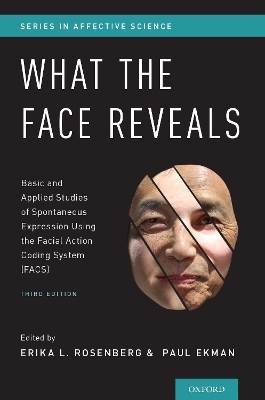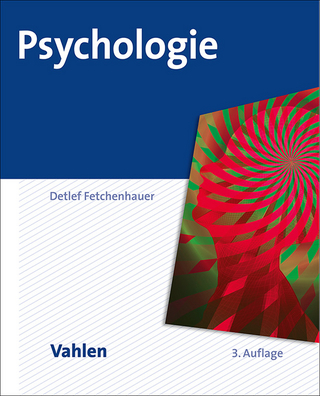
What the Face Reveals
Oxford University Press Inc (Verlag)
978-0-19-020294-1 (ISBN)
New to this Edition:
--Revised to include 50% new contributions, reflecting changes in facial measurement in the 21st century
--New structure organized around six areas of FACS research: Animal FACS, Automated Measurement, Basic Affective Science, Development, Pain, Psychopathology, and Social and Health Psychology
Erika Rosenberg, PhD, a facial scientist who trained with Paul Ekman (senior author of the FACS system), has worked extensively with FACS in both research and applied fields since 1988. She is a Consulting Scientist at the Center for Mind and Brain at UC Davis and Chief Scientific Office at Humain, Ltd. Creator of the 5-day FACS workshop, Dr. Rosenberg has trained hundreds of people around the world to use FACS and contributed to the ongoing development of FACS training tools. She consults on the use of FACS in a variety of contexts including the behavioral sciences, law enforcement, and digital effects. Erika Rosenberg is also a teacher of meditation and co-developer of the Compassion Cultivation Training Program (CCT) at Stanford University. She is Founding faculty at The Compassion Institute (a non-profit devoted to compassion education worldwide), and Faculty at The Nyingma Institute of Tibetan Studies in Berkeley. Paul Ekman, PhD is Professor Emeritus, University of California, San Francisco and co-creator of the Facial Action Coding System (FACS), with Wallace V. Friesen. Dr. Ekman's groundbreaking cross-cultural research on the universality of facial expressions of emotion helped launch the field of emotion research in the mid-late 20th Century. He and Wallace Friesen published the original FACS manual in 1978, and, with Joe Hager, PhD, published its first revision in 2002. Dr. Ekman, is regarded as a pioneer in the study of facial expression, emotion, and deception, and has published thousands of articles, books, and chapters across these areas.
Introduction to the 3rd edition: FACS in the 21st Century (Erika L. Rosenberg)
Section 1: Animal FACS
Chapter 1: Classifying Chimpanzee Facial Expressions Using Muscle Action. (Lisa A. Parr, Bridget M. Waller, Sarah J. Vick, and Kim A. Bard)
Afterword: Ten years after ChimpFACS. (Parr)
Chapter 2: Pedomorphic facial expressions give dogs a selective advantage. (Bridget M. Waller, Kate Peirce, Cátia C. Caeiro1, Linda Scheider, Anne M. Burrows, Sandra McCune, and Juliane Kaminski)
Afterword: Extending FACS beyond primates (Waller)
Chapter 3: EquiFACS: The Equine Facial Action Coding System (Coding System (Jen Wathan, Anne M. Burrows, Bridget M. Waller, Karen McComb.)
Afterword: What might comparisons across species reveal? (Wathan)
Section 2: Automated FACS measurement
Chapter 4: Signal characteristics of spontaneous facial expressions: Automatic movement in solitary and social smiles. (Karen L. Schmidt, Jeffrey F. Cohn, & Yingli Tian)
Chapter 5: Toward automatic recognition of spontaneous facial actions
(Marian Stewart Bartlett, Javier R. Movellan, Gwen LIttlewort, Bjorn Braathen, Mark G. Frank, & Terrance J. Sejnowski)
Afterword: The next generation of automated facial measurement. (Movellan & Bartlett)
Chapter 6: Spontaneous facial expression in unscripted social interactions can be measured automatically (Jeffrey M. Girard, Jeffrey F. Cohn, Laszlo A. Jeni, Michael A. Sayette, & Fernando De la Torre.)
Afterword: Generalizability of automated AU detection (Girard & Cohn)
Section 3: Basic Affective Science
Chapter 7: Differentiating emotion elicited and deliberate emotional facial expression (Ursula Hess & Robert E. Kleck)
Afterword: Objective Differences versus Observer's Ratings. (Hess)
Chapter 8: Smiles When Lying (Paul Ekman, Maureen O' Sullivan* & Wallace Friesen*)
Afterword: Smiles when lying (Ekman)
Chapter 9: Coherence between expressive and experiential systems in emotion
(Erika L. Rosenberg & Paul Ekman)
Afterword: Emotions as unified responses (Rosenberg)
Chapter 10: Signs of appeasement: Evidence for distinct displays of embarrassment, amusement, and shame (Dacher Keltner)
Afterword: The forms and functions of embarrassment (Keltner).
Section 4: Development
Chapter 11: Differential Facial Responses to Four Basic Tastes in Newborns
(Diane Rosenstein & Harriet Oster)
Afterword: Facial Expression as a Window on Sensory Experience and Affect in Newborn Infants: Research with Baby FACS (Oster)
Chapter 12: Do Infants Show Distinct Negative Facial Expressions for Fear and Anger? Emotional Expression in 11-Month-Old European American, Chinese, and Japanese Infants (Linda A. Camras, Harriet Oster, Roger Bakeman, Zhaolan Meng, Tatsuo Ujiie, & Joseph J. Campos.)
Afterword: Studying Infant Facial Expressions Across Cultures (Camras, Oster, & Campos)
Chapter 13: All smiles are positive, but some smiles are more positive than others.(Daniel S. Messinger, Alan Fogel & K. Laurie Dickson)
Afterword: Smile on: New developments in measuring and modeling positive affect. (Messinger)
Chapter 14: Facial expressions of emotion and psychopathology in adolescent boys (Dacher Keltner Terrie E. Moffitt & Magda Stouthamer-Loeber)
Afterword: Facial expression, personality, and psychopathology (Keltner)
Section 5: Pain
Chapter 15: Genuine, suppressed, and faked facial behavior during exacerbation of chronic low back pain (Kenneth D. Craig, Susan A. Hyde, & Christopher J. Patrick)
Afterword: On Knowing Another's Pain (Craig)
Chapter 16: Pain and Disgust: The Facial Signaling of Two Aversive Bodily Experiences (Miriam Kunz, Jessica Peter, Sonja Huster, & Stefan Lautenbacher
Afterword: The question of uniqueness of the facial expression of pain (Lautenbacher & Kunz)
Chapter 17: The influence of communicative relations on facial responses to pain: Does it matter who is watching? (Anna J. Karmann, Stefan Lautenbacher, Florian Bauer, & Miriam Kunz )
Afterword: How social context shapes the way we facially express pain (Kunz & Lautenbacher)
Chapter 18: Effects of Alzheimer Disease on the Facial Expression of Pain
(Paul A. Beach, Jonathan T. Huck, Melodie M. Miranda, Kevin T. Foley, MD, & Andrea C. Bozoki,)
Afterword: The face of pain in Alzheimer's disease (Beach)
Section 6: Psychopathology
Chapter 19: Facial expression in affective disorders (Paul Ekman, David Matsumoto, & Wallace Friesen*)
Afterword: Depression and expression (Ekman)
Chapter 20: Interaction Regulations Used by Psychiatric and Psychosomatic Patients.(Evelyne Steimer-Krause, Rainer R. Krause, and Günter Wagner).
Afterword: Update on the Research on Dyadic Interaction of Behaviors in Psychotherapy (Krause)
Chapter 21: Affective relationship patterns and psychotherapeutic change
(Eva Bänninger-Huber & Christine Widmer)
Afterword: Interactive relationship patterns in every day interactions and in psychotherapy (Bänninger-Huber & Huber)
Chapter 22: Nonverbal social withdrawal in depression: Evidence from manual and automatic analyses (Jeffrey M. Girard, Jeffrey F. Cohn, Mohammad H. Mahoor, Mohammad Mavadati, Zakia Hammal, & Dean P. Rosenwald)
Afterword: Automated Analysis of Depressed Behavior (Girard & Cohn)
Chapter 23: Duchenne display responses towards sixteen enjoyable emotions: Individual differences between no and fear of being laughed at (Tracey Platt, Jennifer Hofmann, Willibald Ruch, & Rene T. Proyer.)
Afterword: The role of enjoyable emotions in understanding the fear of being laughed at (Platt )
Section 7: Social & Health Psychology
Chapter 24: Linkages between facial expressions of emotion and transient myocardial ischemia in men with coronary disease (Erika Rosenberg, Paul Ekman, R. Edward Coleman, Wei Jiang, Michael Hanson, Christopher O' Connor, Robert Waugh, & James A. Blumenthal)
Afterword: Facial expression and emotion in the study of heart disease (Rosenberg)
Chapter 25: Extraversion, alcohol, and enjoyment. (Willibald Ruch)
Afterword: Laughter and cheerfulness (Ruch)
Chapter 26: The Effects of alcohol on the emotional displays of whites in interracial groups (Catharine E. Fairbairn, Michael A. Sayette, John M. Levine, Jeffrey F. Cohn, and Kasey G. Creswell)
Afterword: Using FACS to understand underlying processes during social exchange both inside and outside the laboratory. (Fairbairn & Sayette)
Chapter 27: Alcohol and Group Formation: A Multimodal Investigation of the Effects of Alcohol on Emotion and Social Bonding (Michael A. Sayette, Kasey G. Creswell, John D. Dimoff, Catharine E. Fairbairn, Jeffrey F. Cohn, Bryan W. Heckman, Thomas R. Kirchner, John M. Levine, and Richard L. Moreland)
Afterword: Use of FACS in a social context can enhance understanding of addiction (Sayette & Fairbairn)
Chapter 28: Intensive Meditation Training Influences Emotional Responses to Suffering (Erika L. Rosenberg, Anthony P. Zanesco, Brandon G. King, Stephen R. Aichele, Tonya L. Jacobs, David A. Bridwell, Katherine A. MacLean, Phillip R. Shaver, Emilio Ferrer, Baljinder K. Sahdra, Shiri Lavy, B. Alan Wallace, and Clifford D. Saron)
Afterword: Mind training and facial emotion: A New Frontier (Rosenberg)
***
Concluding Commentary by Paul Ekman: FACS: Yesterday and Today
(Paul Ekman)
| Erscheinungsdatum | 03.01.2020 |
|---|---|
| Reihe/Serie | Series in Affective Science |
| Verlagsort | New York |
| Sprache | englisch |
| Maße | 236 x 163 mm |
| Gewicht | 1043 g |
| Themenwelt | Geisteswissenschaften ► Psychologie ► Allgemeine Psychologie |
| Geisteswissenschaften ► Psychologie ► Verhaltenstherapie | |
| ISBN-10 | 0-19-020294-7 / 0190202947 |
| ISBN-13 | 978-0-19-020294-1 / 9780190202941 |
| Zustand | Neuware |
| Informationen gemäß Produktsicherheitsverordnung (GPSR) | |
| Haben Sie eine Frage zum Produkt? |
aus dem Bereich


